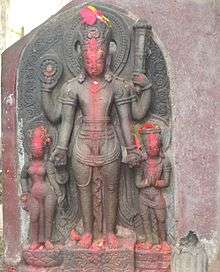Hari


Hari (Devanagari: हरि), the one who forgives all sins, is a primary god in Hinduism who is an aspect of Vishnu. The terms "Hari" and "Vishnu" are almost used interchangeably. He is described as having the dark complexion of water-filled clouds and having four arms. He is depicted as a pale-blue being, as are his incarnations Rama and Krishna. He holds a padma (lotus flower) in his lower left hand, the Kaumodaki gada (mace) in his lower right hand, the Panchajanya shankha (conch) in his upper left hand and the discus weapon considered to be the most powerful weapon according to Hindu Religion Sudarshana Chakra in his upper right hand and also have a bow named as sharanga and due to which he is sometimes named as sharangapani (hari) in Bhagvad Gita. Om precedes all else as in Om Namah Shivaya, Om Namo Bhagavate Vasudevaya, Om Namo Narayanaya. But only Hari precedes Om in the form of Harih om or Harih om tat sat.
The word "Hari" is widely used in later Sanskrit and Prakrit literature, Hindu, Buddhist, Jain and Sikh religions. It appears as 650th name of Vishnu in the Vishnu sahasranama of the Mahabharata and hence rose to special importance in Hindu Vaishnavism.
Etymology
The Sanskrit word hari means green or yellow and derives from the Proto-Indo-European root *ǵʰel- 'to shine; to flourish; green; yellow', which also gave rise to Persian zar 'gold', Greek khloros 'green', Slavic zelen 'green' and zolto 'gold', as well as English yellow and gold. The same root occurs in other Sanskrit words like haridrā, 'turmeric', named for its yellow color.
Other Names of Hari
There are many names of lord Hari defined in holy books of Hinduism such as Bhagwad Gita and Mahabharata and many other holy books. some of them which are used usually.
Usage in Indian religion and mythology
- The Harivamsha ("lineage of Hari") is a text in both the Puranic and Itihasa traditions.
- As the name of tawny-colored animals, hari may refer to lions (also a name of the zodiacal sign Leo), bay horses, or monkeys. The feminine Harī is the name of the mythological "mother of monkeys" in the Sanskrit epics.
- Hari is the name of a class of gods under the fourth Manu (manu tāmasa, "Dark Manu") in the Puranas.
- In Hinduism, beginning with Adi Sankara's commentary on the Vishnu sahasranama, hari became etymologized as derived from the verbal root hṛ "to grab, seize, steal", in the context of Vaishnavism interpreted as "to take away or remove evil or sin",[1] and the name of Vishnu rendered as "he who destroys samsara", which is the entanglement in the cycle of birth and death, along with ignorance, its cause;[2] compare hara as a name of Shiva, translated as "seizer" or "destroyer".
- In the Gaudiya Vaishnava tradition, Hari is a name of both Krishna or Vishnu, invoked in the Hare Krishna mantra (Hare is a vocative form of Harih, used in mahamantra).
- The element hari is found in a number of Hindu given names, e.g. Bhartrhari, Harendra (i.e. hari-Indra), Harisha (i.e. hari-Isha), Hariprasad, Harikesh (Harikesha, "golden-haired", also a name of Shiva and of Savitar), etc.
- In Sikhism, it is the holy symbol consisting of the three Gurmukhi letters and is used as "हरि" "ਹਰਿ". The Guru Granth Sahib which Sikhs revere as their 11th guru contains this word more than 8500 times.
